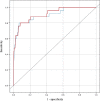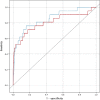Machine Learning techniques in breast cancer prognosis prediction: A primary evaluation
- PMID: 32154669
- PMCID: PMC7196042
- DOI: 10.1002/cam4.2811
Machine Learning techniques in breast cancer prognosis prediction: A primary evaluation
Abstract
More than 750 000 women in Italy are surviving a diagnosis of breast cancer. A large body of literature tells us which characteristics impact the most on their prognosis. However, the prediction of each disease course and then the establishment of a therapeutic plan and follow-up tailored to the patient is still very complicated. In order to address this issue, a multidisciplinary approach has become widely accepted, while the Multigene Signature Panels and the Nottingham Prognostic Index are still discussed options. The current technological resources permit to gather many data for each patient. Machine Learning (ML) allows us to draw on these data, to discover their mutual relations and to esteem the prognosis for the new instances. This study provides a primary evaluation of the application of ML to predict breast cancer prognosis. We analyzed 1021 patients who underwent surgery for breast cancer in our Institute and we included 610 of them. Three outcomes were chosen: cancer recurrence (both loco-regional and systemic) and death from the disease within 32 months. We developed two types of ML models for every outcome (Artificial Neural Network and Support Vector Machine). Each ML algorithm was tested in accuracy (=95.29%-96.86%), sensitivity (=0.35-0.64), specificity (=0.97-0.99), and AUC (=0.804-0.916). These models might become an additional resource to evaluate the prognosis of breast cancer patients in our daily clinical practice. Before that, we should increase their sensitivity, according to literature, by considering a wider population sample with a longer period of follow-up. However, specificity, accuracy, minimal additional costs, and reproducibility are already encouraging.
Keywords: Artificial Neural Network (ANN); Support Vector Machine (SVM); algorithm; breast cancer; predictive models.
© 2020 The Authors. Cancer Medicine published by John Wiley & Sons Ltd.
Conflict of interest statement
The authors have no conflicts of interest to declare.
Figures





Similar articles
-
Predicting disease recurrence in breast cancer patients using machine learning models with clinical and radiomic characteristics: a retrospective study.J Egypt Natl Canc Inst. 2024 Jun 10;36(1):20. doi: 10.1186/s43046-024-00222-6. J Egypt Natl Canc Inst. 2024. PMID: 38853190
-
Prediction of one-year recurrence among breast cancer patients undergone surgery using artificial intelligence-based algorithms: a retrospective study on prognostic factors.BMC Cancer. 2025 May 26;25(1):940. doi: 10.1186/s12885-025-14369-5. BMC Cancer. 2025. PMID: 40419997 Free PMC article.
-
Evaluation of Prognosis in Nasopharyngeal Cancer Using Machine Learning.Technol Cancer Res Treat. 2020 Jan-Dec;19:1533033820909829. doi: 10.1177/1533033820909829. Technol Cancer Res Treat. 2020. PMID: 32138606 Free PMC article.
-
The natural history of operable breast cancer after primary treatment.Ann Oncol. 1995;6 Suppl 2:11-21. doi: 10.1093/annonc/6.suppl_2.s11. Ann Oncol. 1995. PMID: 8547190 Review.
-
Machine learning applications in cancer prognosis and prediction.Comput Struct Biotechnol J. 2014 Nov 15;13:8-17. doi: 10.1016/j.csbj.2014.11.005. eCollection 2015. Comput Struct Biotechnol J. 2014. PMID: 25750696 Free PMC article. Review.
Cited by
-
Construction and Validation of a Newly Prognostic Signature for CRISPR-Cas9-Based Cancer Dependency Map Genes in Breast Cancer.J Oncol. 2022 Jan 19;2022:4566577. doi: 10.1155/2022/4566577. eCollection 2022. J Oncol. 2022. PMID: 35096059 Free PMC article.
-
Classification of Breast Cancer Nottingham Prognostic Index Using High-Dimensional Embedding and Residual Neural Network.Cancers (Basel). 2022 Feb 13;14(4):934. doi: 10.3390/cancers14040934. Cancers (Basel). 2022. PMID: 35205681 Free PMC article.
-
Direct comparison of three different mathematical models in two independent datasets of EUSOMA certified centers to predict recurrence and survival in estrogen receptor-positive breast cancer: impact on clinical practice.Breast Cancer Res Treat. 2021 Jun;187(2):455-465. doi: 10.1007/s10549-021-06144-4. Epub 2021 Mar 1. Breast Cancer Res Treat. 2021. PMID: 33646494
-
Enhancing breast cancer prediction through stacking ensemble and deep learning integration.PeerJ Comput Sci. 2025 Feb 3;11:e2461. doi: 10.7717/peerj-cs.2461. eCollection 2025. PeerJ Comput Sci. 2025. PMID: 40062255 Free PMC article.
-
Progression-Free Survival Prediction in Patients with Nasopharyngeal Carcinoma after Intensity-Modulated Radiotherapy: Machine Learning vs. Traditional Statistics.J Pers Med. 2021 Aug 12;11(8):787. doi: 10.3390/jpm11080787. J Pers Med. 2021. PMID: 34442430 Free PMC article.
References
-
- Kumar V, Abbas AK, Aster JC. Robbins Basic Pathology. 9th ed, chapter 18. Amsterdam, Netherlands: Elsevier/Saunders; 2013;681‐714.
-
- AIOM, Airtum, Fondazione AIOM . I Numeri Del Cancro in Italia 2017. 2017.
-
- Fitzgibbons PL, Page DL, Weaver D, et al. Prognostic factors in breast cancer. College of American Pathologists Consensus Statement 1999. Arch Pathol Lab Med. 2000;124(7):966‐978. - PubMed
-
- Zeichner SB, Herna S, Mani A, et al. Survival of patients with de‐novo metastatic breast cancer: analysis of data from a large breast cancer‐specific private practice, a university‐based cancer center and review of the literature. Breast Cancer Res Treat. 2015;153(3):617‐624. - PubMed
MeSH terms
LinkOut - more resources
Full Text Sources
Medical

